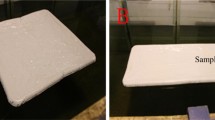Abstract
The recent exponential growth in industrial aquaculture has led to a huge increase in Artemia biomass production in order to meet increased fish production needs. The present study explores the potential use of salt gradient solar ponds (SGSPs) for production of Artemia nauplii. An SGSP is a basin of water where solar energy is trapped and collected via an artificially imposed gradient. Three zones can be identified in an SGSP: upper and lower zones, which are both convective, and a middle zone, which is intended to be non-convective. The latter acts as a transparent insulation layer and allows for storage of solar energy at the bottom, where it is available for use. The combination of salt, temperature and high transparency could make SGSPs promising bioreactors for the production of Artemia nauplii. Using particle image velocymetry (PIV) and Shadowgraph visualisation techniques, the behaviour of Artemia nauplii under critical cultivation parameters (namely, salinity, temperature and light) was monitored to determine movement velocity, and how movement of Artemia affects the salt gradient. It was observed that Artemia nauplii constantly follow light, irrespective of adverse salinity and/or temperature conditions. However, despite the substantial displacement of Artemia following the light source, the salt gradient is not disrupted. The suitability of SGSPs as bioreactors for Artemia biomass production was then tested. The results were disappointing, probably due to the lack of sufficient O2 for Artemia survival and growth. Follow-up trials were conducted aimed at using the SGSP as a green and economically attractive energy source to induce faster hatching of cysts and improved Artemia nauplii growth. The results of these trials, and a case study of Artemia nauplii production using an SGSP, are presented. The authors constructed a Solar Pond device, which they suggest as a novel way of supplying thermal energy for Artemia biomass production in an aquaculture enterprise. Finally, the authors suggest a method of producing and collecting Artemia biomass, and of heating a fish larval tank, in an ‘ideal’ Solar Pond device, profiting from the low investment costs of using a decommissioned salt works.














Similar content being viewed by others
References
Agha KR (2009) The thermal characteristics and economic analysis of a solar pond coupled low temperature multi stage desalination plant. Sol Energy 83:501–510. doi:10.1016/j.solener.2008.09.008
Andrew (2008) http://finfish.org/fishmeal-major-limiter-of-aquaculture-growth
Bønaa KH, Bjerve KS, Straume B, Gram IT, Thelle D (1990) Effect of eicosapentaenoic and docohexaenoic acids on blood pressure in hypertension: a population-based intervention trial from the Tromso study. N Engl J Med 322:795–801
Collares PM, Joyce A, Giestas M, Tavares C (2005) Solar Pond technologies: a review and future directions. In: Yogi Goswami D (ed) Advances in solar energy, vol 16. An annual review of research and development. American Solar Energy Society, Earthscan, London, pp 233–294
Crawford M (2000) Placental delivery of arachidonic acid and docohexaenoic acids: implications of the lipid nutrition of preterm infants. Am J Clin Nutr 71:275S–284S
Dratz EA, Deese AJ (1986) The role of docosahexanoic acid (22:6 w3) in biological membranes: examples from photoreceptors and model membrane bilayers. In: Simopoulos AP, Kifer RR, Martin RE (eds) Health effects of polyunsaturated fatty acids in seafood. Academic, Orlando, pp 319–352
Giestas M, Pina H, Joyce A (1996) The Influence of radiation absorption on solar ponds stability. Int J Heat Mass Transfer 39(18):3873–3885. doi:10.1016/0017-9310(96)00052-X
Simopoulos AP (1986) Historical perspective, conference conclusions and recommendations, and actions by federal agencies. In: Simopoulos AP, Kifer RR, Martin RE (eds) Health effects of polyunsaturated fatty acids in seafood. Academic, Orlando, pp 3–29
SOFIA (2002) Agency’s state of world fisheries and aquaculture report. http://www.fao.org/
Szacsvay T, Hofer-Noser P, Posnansky M (1999) Technical and economic aspects of small-scale solar-pond-powered seawater desalination systems. Desalination 122:185–193. doi:10.1016/S0011-9164(99)00040-5
Tavares CF, Coelho J, Castro Alves D, Abreu M, Joyce A, Fernandes E (2008) Experimental study of a gradient layer with application to Solar Ponds. In: 1st international conference on solar heating, cooling and buildings. EuroSun 2008, Lisbon, October 2008
Thies F, Garry JM, Yagoob P, Rerkasem K, Williams J, Shearman CP (2003) Association of n-3 polyunsaturated fatty acids with stability of atherosclerotic plaques: a randomized controlled trial. Lancet 361:477–485. doi:10.1016/S0140-6736(03)12468-3
Vitale JJ (1988) Lipids, host defenses and immune function. In: Beare-Rogers (ed) Dietary fat requirements in health and development. American Oil Chemists Society, Champaign, pp 137–141
Lavens P, Sorgeloos P (1996) Manual on the production and use of live food for aquaculture. In: Lavens P, Sorgeloos P (eds) FAO fisheries technical paper No. 361. FAO, Rome, p 295
Lavens P, Sorgeloos P (2000) The history, present status and prospects of the availability of Artemia cysts for aquaculture. Aquaculture 181:397–403. doi:10.1016/S0044-8486(99)00233-1
Wear R, Haslett SJ, Alexander NL (1986) Effects of temperature and salinity on the biology of Artemia fransiscana Kellogg from Lake Grassmere, New Zealand. 2. Maturation, fecundity and generation times. J Exp Mar Biol Ecol 98:167–183. doi:10.1016/0022-0981(86)90081-X
Zmora O, Avital E, Gordin H (2002) Results of an attempt for mass production of Artemia in extensive ponds. Aquaculture 213:395–400. doi:10.1016/S0044-8486(02)00054-6
Acknowledgments
The work was supported by FCT Project PPCDT/EME/58807/2004. The authors also thank Rosemarie and Gerriet Retief for English correction.
Author information
Authors and Affiliations
Corresponding author
Rights and permissions
About this article
Cite this article
Gouveia, L., Sousa, J., Marques, A. et al. Solar Pond devices: free energy or bioreactors for Artemia biomass production?. J Ind Microbiol Biotechnol 36, 1035–1045 (2009). https://doi.org/10.1007/s10295-009-0585-0
Received:
Accepted:
Published:
Issue Date:
DOI: https://doi.org/10.1007/s10295-009-0585-0




